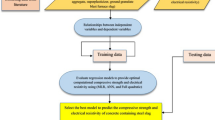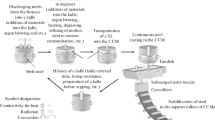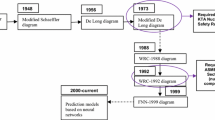Abstract
The mechanical properties of steel coils can be predicted prior to the galvanizing process, thereby preventing the production of galvanized steel coils that are not suitable for the customer’s purpose. At the same time, this will reduce the waste of zinc and unfriendly effects on the environment. The purpose of this paper is to present a comparative assessment of the different techniques currently being used to estimate the mechanical properties of steel coils before being processed on the hot dip galvanizing line (HDGL). The authors have evaluated the models established by linear and non-linear, bagging and other more aggregated construction techniques. Using a total of 30 models, predictions were made for each parameter in order to obtain valuable information about the capabilities of these models and techniques. Each model was tested against each data set ten times. Also, models were constructed to determine the relevance of steel grade to the accuracy of the models’ predictions by excluding from the models any consideration of steel grade. As a result of our tests of these models, it is possible to recommend the model to choose for each parameter.
Similar content being viewed by others
References
Alegre E., Barreiro J., Cáceres H., Hernández L.K., Fernández R.A., Castejón-Limas M. (2006) Design of a computer vision system to estimate tool wearing. Materials Science Forum 526: 61–66
Alonso F.J., Salgado D.R. (2008) Analysis of the structure of vibration signals for tool wear detection. Mechanical Systems and Signal Processing 22(3): 735–748
Astashkin V.I., Ivanik E.G. (1993) Analytical investigation of the process of formation of non-homogeneous composition state of a steel plate during rapid cooling. Fiziko-Khimicheskaya Mekhanika Materialov 29(6): 101–104
Barreiro J., Castejón M., Alegre E., Hernández L.K. (2008) Use of descriptors based on moments from digital images for tool wear monitoring. International Journal of Machine Tools & Manufacture 48(9): 1005–1013. doi:10.1016/j.ijmachtools.2008.01.005
Black, P. E. (2005). “best-first search”. In P. E. Black (Ed.), Dictionary of algorithms and data structures. Gaithersburg: U.S. National Institute of Standards and Technology.
Boccaletti S., Latora V., Moreno Y., Chavez M., Hwang D.-U. (2006) Complex networks: structure and dynamics. Physics Reports 424(4–5): 175–308. doi:10.1016/j.physrep.2005.10.009
Breiman L. (1996) Bagging predictors. Machine Learning 24(2): 123–140
Castejón M., Alegre E., Barreiro J., Hernández L.K. (2007) On-line tool wear monitoring using geometric descriptors from digital images. International Journal of Machine Tools & Manufacture 47(12–13): 1847–1853. doi:10.1016/j.ijmachtools.2007.04.001
Castejón-Limas M., Ordieres-Meré J.B., Martínez-de-Pisón-Ascacíbar F.J., Vergara-González E.P. (2004) Outlier detection and data cleaning in multivariate non-normal samples: the PAELLA algorithm. Data Mining and Knowledge Discovery 9(2): 171–187
Chang P.C., Liu C.H., Wang Y.W. (2006) A hybrid model by clustering and evolving fuzzy rules for sale forecasting in printed circuit board industry. Decision Support Systems 42(3): 1254–1269. doi:10.1016/j.dss.2005.10.013
Chang P.C., Warren L.T. (2006) Combing SOM and fuzzy rule base for flow time prediction in semiconductor manufacturing factory. Applied Soft Computing 6(2): 198–206. doi:10.1016/j.asoc.2004.12.004
Ciampi A., Lechevallier Y., Castejón-Limas M., González-Marcos A. (2008) Hierarchical clustering of sub-populations with a dissimilarity based on the likelihood ratio statistic: application to clustering massive data sets. Pattern Analysis & Applications 11(2): 199–220. doi:10.1007/s10044-007-0088-4
Datta S., Pettersson F., Ganguly S., Saxén H., Chakraborti N. (2007) Designing high strength multi-phase steel for improved strength-ductility balance using neural networks and multi-objective genetic algorithms. ISIJ International 47(8): 1195–1203
Deb S., Ghosh K., Paul S. (2006) A neural network based methodology for machining operations selection in computer-aided process planning for rotationally symmetrical parts. Journal of Intelligent Manufacturing 17(5): 557–569. doi:10.1007/s10845-006-0026-0
DelCoz Díaz J.J., García Nieto P., Betegón C., Fernández G. (2006a) Non-linear analysis of unbolted base plates by the FEM and experimental validation. Thin-Walled Structures 44(5): 529–541
DelCoz Díaz J.J., García Nieto P.J., Martín Rodríguez A., Lozano Martínez-Luengas A., Betegón Biempica C. (2006b) Non- linear thermal analysis of light concrete hollow brick walls by the finite element method and experimental validation. Applied Thermal Engineering 26(8–9): 777–786
DelCoz Díaz J.J., García Nieto P., Suarez Domiguez F.J. (2005) Numerical analysis of the behaviour of tooth intraradial posts by the finite element method. Journal of Mathematical Modelling and algorithms 4(3): 275–287
DelCoz Díaz J.J., García Nieto P.J., Suarez Domínguez F.J. (2006c) Numerical analysis of pressure field on curved self-weighted metallic roofs due to the wind effect by the finite element method. Journal of Computational and Applied Mathematics 192: 40–50. doi:10.1016/j.cam.2005.04.035
DelCoz Díaz J.J., Rodríguez Mazón F., Garcia Nieto P., Suárez Domínguez F. (2002) Design and finite element analysis of a wet circle cement rotary klin. Finite Elements in Analysis and Design 39(1): 17–42
Dobrzański L.A., Kowalski M., Madejski J. (2005) Methodology of the mechanical properties prediction for the metallurgical products from the engineering steels using the artificial intelligence methods. Journal of Materials Processing Technology 164(−165): 1500–1509
Dorogovtsev S.N., Mendes J.F.F. (2002) Evolution of networks. Advances in Physics 51(4): 1079–1187
González-Marcos A., Castejón-Limas M., Alba-Elías F., Torre V. (2008) Development of neural network-based models to predict mechanical properties of hot dip galvanised steel coils. Revista Española de Metalurgia 45: 45–53
Gonzalez-Marcos A., Pernia-Espinoza A.V., Alba-Elías F., García-Forcada A. (2007) A neural network-based approach for optimising rubber extrusion lines. International Journal of Computer Integrated Manufacturing 20(8): 828–837
Frank E., Trigg L., Holmes G., Witten I.H. (2000) Technical note: Naive Bayes for regression. Machine Learning 41(1): 5–25
Freund Y., Schapire R.E. (1997) A decision-theoretic generalization of on-line learning and an application to boosting. Journal of Computer and System Sciences 55(1): 119–139
Friedman J., Hastie T., Tibshirani R. (2000) Additive logistic regression: a statistical view of boosting. Annals of Statistics 28(2): 337–407
Funahashi K. (1989) On the approximate realization of continuous mappings by neural networks. Neural Networks 2: 183–192
Haykin S. (1999) Neural networks, a comprehensive foundation (2nd ed.). Prentice Hall, New Jersey
Hippert H.S., Pedreira C.E., Souza R.C. (2001) Neural networks for short-term load forecasting: a review and evaluation. IEEE Transactions on Power Systems 16(1): 44–55
Hornik, K. (2006). The R FAQ, http://www.r-prject.org. ISBN 3-900051-08-9.
Hornik K., Stinchcombe M., White H. (1989) Multilayer feedforward networks are universal approximators. Neural Networks 2: 359–366
Jones D.M., Watton J., Brown K.J. (2006) Prediction and validation of through coil final mechanical properties of high strength hot rolled coil using artificial neural networks. Ironmaking and Steelmaking 33(4): 315–322
Jones D.M., Watton J., Brown K.J. (2007) Comparison of black-, white-, and grey-box models to predict ultimate tensile strength of high-strength hot rolled coils at the Port Talbot hot strip mill. Proceedings of the Institution of Mechanical Engineers, Part L: Journal of Materials: Design and Applications 221(1): 1–9
Kim D.J., Kim Y.C., Kim B.M. (2001) Optimization of the irregular shape rolling process with an artificial neural network. Journal of Materials Processing Technology 113(1–3): 131–135
Kumagai A., Liu T.-I., Hozian P. (2006) Control of shape memory alloy actuators with a neuro-fuzzy feedforward model element. Journal of Intelligent Manufacturing 17(1): 45–56
Kusiak J., Kuziak R. (2002) Modelling of microstructure and mechanical properties of steel using the artificial neural network. Journal of Materials Processing Technology 127(1): 115–121
Kutschenreiter-Praszkiewicz I. (2008) Application of artificial neural network for determination of standard time in machining. Journal of Intelligent Manufacturing 19(2): 233–240
Larkiola J., Myllykoski P., Korhonen A.S., Cser L. (1998) The role of neural networks in the optimisation of rolling processes. Journal of Materials Processing Technology 80(−81): 16–23
Larkiola J., Myllykoski P., Nylander J., Korhonen A.S. (1996) Prediction of rolling force in cold rolling by using physical models and neural computing. Journal of Materials Processing Technology 60(1–4): 381–386
Li F.-F., Zhao Y.-K., Yu H. (2007) Diagonal recurrent neural network and its application in mechanical property prediction of 82B steel. Journal of Iron and Steel Research 19(8): 59–62
MartínezDe Pisón F.J., Alba Elías F., Castejoín Limas M., González Rodríguez J.A. (2006) Improvement and optimisation of hot dip galvanising line using neural networks and genetic algorithms. Ironmaking and Steelmaking 33(4): 344–352
Mclachlan G.J. (1992) Discriminant analysis and statistical pattern recognition. Wiley, New York
Mukhopadhyay A., Iqbal A. (2005) Prediction of mechanical properties of hot rolled, low-carbon steel strips using artificial neural network. Materials and Manufacturing Processes 20(5): 793–812
Ordieres-Meré J.B., González-Marcos A., González J.A., Lobato-Rubio V. (2004) Estimation of mechanical properties of steel strip in hot dip galvanising lines. Ironmaking and Steelmaking 31: 43–50
Pal D., Datta A., Sahay S.S. (2006) An efficient model for batch annealing using a neural network. Materials and Manufacturing Processes 21(5): 567–572
Panda S.S., Chakraborty D., Pal S.K. (2008) Flank wear prediction in drilling using back propagation neural network and radial basis function network. Applied Soft Computing 8(2): 858–871
Parezanović I., Spiegel M. (2005) Selective oxidation and surface segregation in high strength steels during short term annealing in H2-N2—Influence of B on surface chemistry. Steel Research International 76(11): 832–839
Pernía-Espinoza A., Castejón-Limas M., González-Marcos A., Lobato-Rubio V. (2005a) Steel annealing furnace robust neural network model. Ironmaking and Steelmaking 32(5): 418–426
Pernía-Espinoza A.V., Ordieres-Meré J.B., Martínez-de-Pisón F.J., González-Marcos A. (2005b) Tao-robust backpropagation learning algorithm. Neural Networks 18: 191–204
Portnoy S., Koenker R. (1997) The Gaussian hare and the Laplacian tortoise: Computability of squared-error versus absolute-error estimators. Statistical Science 12(4): 279–300
Prendes Gero M.B., Bello García A., DelCoz Díaz J.J. (2005) A modified elitist genetic algorithm applied to the design optimization of complex steel structures. Journal of Constructional Steel Research 61(2): 265–280
Prendes Gero M.B., Bello García A., DelCoz Díaz J.J. (2006) Design optimization of 3D steel structures: genetic algorithm vs. classical techniques. Journal of Constructional Steel Research 62(12): 1303–1309
Quinlan, J. R. (1992). Learning with continuous classes. In Proceedings of the Australian Joint Conference on Artificial Intelligence (pp. 343–348). Singapore: World Scientific.
Rooney, N., Patterson, D., Anand, S., & Tsymbal, A. (2004). Dynamic integration of regression models. Lecture notes in computer science (Vol. 3077, pp. 164–173). Berlin: Springer-Verlag. ISBN 978-3-540-22144-9.
Shevade, S. K., Keerthi, S. S., Bhattacharyya, C., & Murthy, K. R. K. (1999). Improvements to SMO algorithm for SVM regression. Technical report CD-99-16. Control Division, Department of Mechanical and Production Engineering, National University of Singapore.
Sitek W., Dobrzański L.A., Zacłona J. (2004) The modelling of high-speed steels’ properties using neural networks. Journal of Materials Processing Technology 157-158((special issue)): 245–249
Son J.S., Lee D.M., Kim I.S., Choi S.K. (2004) A study on genetic algorithm to select architecture of a optimal neural network in the hot rolling process. Journal of Materials Processing Technology 153-154((1–3): 643–648
Sterjovski Z., Nolan D., Carpenter K.R., Dunne D.P., Norrish J. (2005) Artificial neural networks for modelling the mechanical properties of steels in various applications. Journal of Materials Processing Technology 170(3): 536–544
Uther, W. T. B., & Veloso, M. M. (1998). Tree based discretization for continuous state space reinforcement learning. In Proceedings of the National Conference on Artificial Intelligence, Madison, WI (pp. 769–774). Menlo Park, CA: AAAI.
Wang D.-M., Li Q., Li H.-D. (2007) Quality prediction model and control of the metallic mechanical properties. Kongzhi Lilun Yu Yinyong/Control Theory and Applications 24(4): 669–673
Wang W.H., Hong G.S., Wong Y.S., Zhu K.P. (2007) Sensor fusion for online tool condition monitoring in milling. International Journal of Production Research 45(21): 5095–5116
Wang, Y., & Witten, I. H. (1997). Induction of model trees for predicting continuous classes. In Proceedings of the Poster Papers of the European Conference on Machine Learning (pp. 128–137). University of Economics, Faculty of Informatics and Statistics, Prague.
Weidig U., Kaspar R., Pawelski O., Rasp W. (1999) Multiphase microstructure in steel bars produced by dieless drawing. Steel Research 70(4): 172–177
Wikipedia. (2008). http://en.wikipedia.org/wiki/Support_vector_machine. Section External links. Software.
Wilkinson G.N., Rogers C.E. (1973) Symbolic descriptions of factorial models for analysis of variance. Applied Statistics 22: 392–399
Witten I.H., Frank E. (2005) Data mining: Practical machine learning tools and techniques (2nd. ed). Morgan Kaufmann, San Francisco
Zheleznov Yu.D., Arutyunov I.E., Dolgova O.A., Kotsar S.L., Mukhin Yu.A., Chvilev V.V. (1976) Analysis of distribution curves of mechanical properties. Steel USSR, 6(11): 621–623
Zheng H., Gong D.-Y., Wang G.-D., Liu X.-H., Zhang P.-J. (2007) Software of predicting mechanical properties of strip steel by using BP networks. Journal of Iron and Steel Research 19(7): 54–57+62
Zheng Z. (2000) Constructing conjunctive attributes using production rules. Journal of Research and Practice in Information Technology 32(1): 13–38
Author information
Authors and Affiliations
Corresponding author
Rights and permissions
About this article
Cite this article
Ordieres-Meré, J., Martínez-de-Pisón-Ascacibar, F.J., González-Marcos, A. et al. Comparison of models created for the prediction of the mechanical properties of galvanized steel coils. J Intell Manuf 21, 403–421 (2010). https://doi.org/10.1007/s10845-008-0189-y
Received:
Accepted:
Published:
Issue Date:
DOI: https://doi.org/10.1007/s10845-008-0189-y




